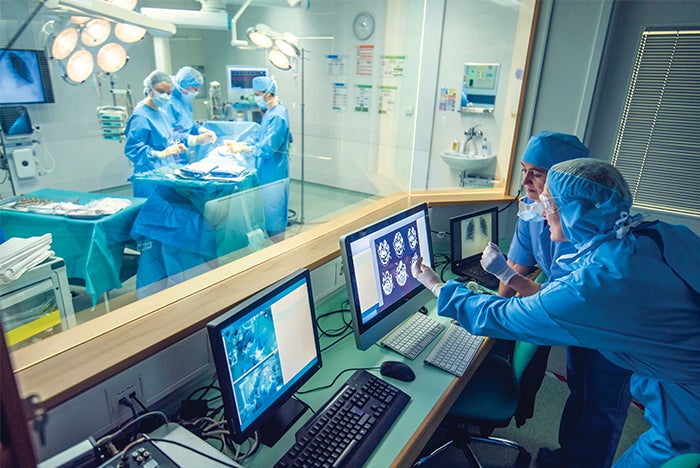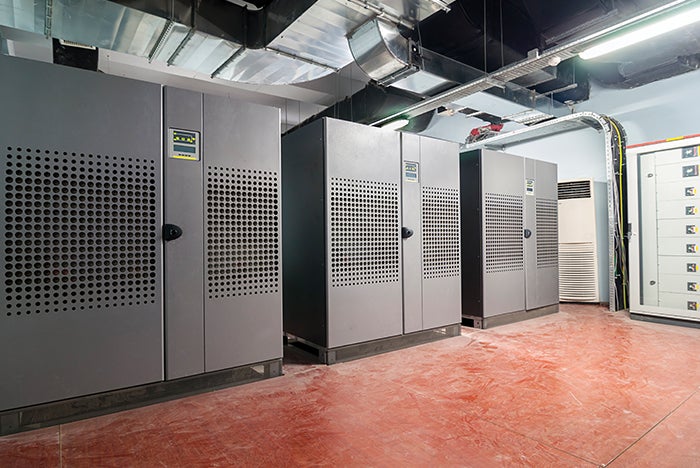Powering up to meet today's health technology demands

The rapid growth of health care technology has put new demands on health care facility electrical systems.
Image by Getty Images
The rapid growth of health care technology has put new demands on health care electrical systems within hospitals and other health care facilities. Increasingly, higher technology is seen throughout the modern health care facility. Areas such as surgery, imaging, other clinical spaces, laboratories and even facilities services departments have been consistently increasing their use of technology.
Technology applications include patient information, electronic health records, electronic medical records, picture archiving and communication systems, and even more subsets of information technology systems and communications, including mass notification systems. Real-time locating systems and radio frequency identification are used for both asset tracking, such as relocatable medical equipment, and also for improving the safety and security of vulnerable patients.
The increasing digitization of health care results in technology more broadly located than before, including self-service devices such as tablets, kiosks, consent forms, copay processes, wayfinding, scheduling and preregistration. Robotic devices are used in surgical areas, for transporting medication and elsewhere.
Other growing uses of technology include holographic imaging, augmented reality, virtual reality, artificial intelligence and 3D printing. Remote monitoring and remote diagnostics also are in greater use, along with additional mobile devices.
There appears to be a trend for health care facilities to plan for more extensive operations in island mode, with more comprehensive services under emergency conditions for longer periods. Some of this may be in response to the Centers for Medicare & Medicaid Services’ (CMS’s) emergency preparedness final rule.
And much of this new technology is likely to be considered mission critical by health care organizations based upon new realities in patient care. Responding to this growing reality of maintaining business continuity during a prolonged utility blackout may require considerations beyond the historical regulatory codes and standards compliance approaches, particularly with respect to emergency power and even other critical in-house utilities.
New challenges
Some loads, such as large imaging equipment, HVAC, elevators, medical vacuum pumps and air compressors, pneumatic tube blowers and even some safety systems, can create a power distribution environment unfriendly to sensitive high-technology devices. Much of the newer technology may be more susceptible to power supply fluctuations than legacy equipment such as lights and motors. As a result, many facilities are being constructed or upgraded with more power conditioning equipment such as uninterruptible power supplies (UPSs).
Historically, UPSs would usually be found serving data centers, selected sensitive laboratory equipment and imaging equipment, some equipment within information technology (IT) rooms and the like. The broadening applications of sensitive technology equipment are likely to result in broader, more scalable approaches to UPS applications. This trend may improve some patient experiences by mitigating the potential for power supply fluctuations adversely impacting imaging quality, thereby resulting in the need for repeat imaging sessions. UPSs should also be tolerant of both upstream and downstream influences.
Medical lasers in many health care facilities are now rental devices, making it more difficult for designers to predict what the individual laser loads will be and where those laser loads will need to be served. The use of portable X-ray machines within individual patient rooms has a similar impact on patient room and patient area designs — what and where will the portable X-ray loads be experienced?
Facilities that need additional sterilization may choose to supplement existing steam sterilizers with new electrical sterilizers. This approach may increase electrical loads beyond earlier load growth projections.
Historically, codes and standards have not mandated that cooling be powered by the health care facility’s emergency power system. That system generally has been regulated as the Emergency Power Supply System (EPSS) by NFPA 110, Standard on Emergency Power Supplies, as the Essential Electrical System (EES) by both NFPA 70®, National Electrical Code®, Article 517; and NFPA 99, Health Care Facilities Code, Chapter 6; and now also by the CMS emergency preparedness final rule.
However, with much of this critical high-technology patient care equipment requiring a specified temperature environment, it is easy to envision the addition of more than the historical code-based cooling loads to the EES. Some larger equipment, such as imaging equipment, may require supplemental cooling in unexpected areas.
Those with both health care design and operations experience understand that change is a constant in health care facilities. And much of this change is unpredictable, with concepts that change as the health care market fluctuates.
Power systems and equipment serving this critical technology equipment must be reliable, manageable and highly scalable. The power systems also must be flexible enough to incorporate other building system modifications reflecting the changing needs (e.g., space, servers, data racks, weight, air changes, pressure relationships, temperature control and relative humidity) and management systems capable of integrating the technology equipment changes.
Many of these devices, along with additional devices that may be used with them, are likely to require connectivity to an effective, robust, safe and secure “internet of things.” Data may be in the cloud or in disparate systems communicating with each other.
Within the support services departments, examples include communication between surgical scheduling and building automation systems, and among nursing units, patient transport and environmental services. Facilities equipment can have bar codes or QR codes that allow facilities professionals with tablets convenient field access to refer to maintenance procedures, repair procedures, lockout/tagout procedures or even failure procedures.
Communications systems are likely to expand further than previously expected based on all of this. Some states now require that technology drawings, such as communications systems drawings, have a registered professional engineer seal for construction purposes. Wide area networks may be required beyond the walls of the hospital if they are not already expanded to that degree. The need for cellular data connectivity also may be more prevalent than previous approaches.
The breadth and hospitalwide use of high-technology equipment is likely to cause a broader emergency power use than previously considered based upon many of the above issues.
Going beyond patient care activities, some facilities are also responding to a demand for outlets to serve patient and family electronic devices. This response might include charging pads or receptacles built into furniture similar to those found within modern airport gate areas.
Responses to failures
A 2014 ASHE study found that the frequency of electrical utility outages affecting hospitals has been increasing. Any external or internal electrical power equipment item can fail, whether it is a utility circuit, switchgear lineup, transformer, motor control center, generator, paralleling switchgear, transfer switch, panelboard, battery, flywheel or other UPS technology, distribution riser, distribution feeder or other item. Similarly, any single room can become untenable for equipment operation, including rooms housing many of these items and even different pieces of equipment intended to be redundant to each other.
Consideration may be given to the potential reality of such unexpected failures and factor some high-reliability data center design concepts into additional critical areas and critical high-technology equipment. The concept of N+1 equipment design is well known; for example, providing a three-generator system where the maximum load requires only two generators at a time. Designs may also recognize that redundant equipment feeding a single distribution pathway still has the potential for a common-mode failure of the distribution pathway itself. In that case, this approach would not solve the problem.
Facility professionals and design engineers understand the ongoing nature of infrastructure changes in health care facilities. The multitude of infrastructure changes over many years might have resulted or could potentially result in downstream load movement and load increases that are not being monitored and reported.
Some legacy power systems with flexible switching capability (e.g., main-tie-main circuit breaker designs) may no longer be capable of safely responding to their original design intent. Therefore, when conditions mandate operating the original main-tie-main design intent, the unmonitored load increases can cause unexpected overload tripping of the remaining main circuit breaker. Modern equipment (even at the circuit breaker level) can have integral load metering and remote reporting capabilities that can alleviate these types of situations moving forward.
Another potentially negative impact of ongoing operational changes are when future changes disturb the original design separation intent of power systems. For example, assume the original design intent was for two power sources, called “Train A” and “Train B.” Trains A and B are arranged such that the loss of one train will still allow required ventilation pressure relationships, air changes, cooling, water pressure, clinical processes and other elements to each critical area. This concept requires that future changes be true to it; however, relocation of processes and expansion/contraction of areas can negatively affect the potential for that desired outcome. Renovations should consider this issue.
Many health care facilities have at least two incoming electrical utility circuits, and larger facilities often have many more. If those circuits come from the same electrical utility substation, a common-mode failure at the utility substation could take down an entire health care facility, a situation that occurred recently.
Circuit routing could also be a potential common-mode failure risk. Some hospitals have redundant utility circuits approaching the hospital property on the same utility poles. Although some electrical utility companies are not as forthcoming with information as they were in the past, health care facility professionals and design engineers should consider discussing with the electrical utility the degree of common mode failure potential inherent in both existing and proposed health care facility multiple circuit arrangements.
Maintenance and repair
Automatic transfer switches (ATSs) and other portions of the emergency power supply system must be maintained in accordance with manufacturer recommendations, according to NFPA 110. Bypass-isolation ATSs can be operated to allow safe equipment maintenance without turning off the critical loads powered by the ATS. Many organizations have decided to replace their legacy non-bypass isolation ATSs with more modern ATSs that incorporate the bypass-isolation feature.
Modern electrical power equipment can be provided with internal monitoring devices that report internal equipment conditions remotely. This capability provides predictive maintenance input that can facilitate both cost reductions and safer, more reliable equipment operation.
Other potential options are redundant breakers or feeders, arc flash reduction maintenance switches and/or zone selective interlocking.
With the CMS Tag A-0724 and its broad requirements for equipment maintenance, new equipment, systems and areas should be designed for effective maintenance with minimal adverse impact to patient care. Knowledgeable maintenance personnel should provide input to the design engineers about the operational needs for this maintenance.
NFPA 70-2017 Article 700.3(F), Temporary Source of Power for Maintenance or Repair of the Alternate Source of Power, requires exterior quick connect capability for single generator installations powering NEC Article 700 loads. The purpose of the newly required quick connect is to allow powering the mandated loads from a portable generator during maintenance or repair of the permanent generator. Although, as an NFPA 70 requirement, this is not a retroactive requirement, new single-generator installations will require it. Many health care facilities have installed these or similar devices already. Facilities with existing similar devices may also want to review their existing installations against the details of 700.3(F).
Mobile equipment considerations also may include the potential need for mobile boilers or mobile chillers. This equipment also may require temporary power from an emergency power source.
Booming growth
The growth rate of new technologies is rapidly increasing in modern health care facilities. This booming growth rate raises challenges in health care power system designs. Power supplies to much of the high-technology equipment must be more stable with fewer or no fluctuations than more robust legacy equipment could resist.
These issues are driving increased utilization of power conditioning equipment and UPSs. The importance of the new technologies is likely to increase the use of emergency power for more of this new critical equipment.
David L. Stymiest, PE, CHFM, CHSP, FASHE, is a senior consultant at Smith Seckman Reid, Nashville, Tenn., specializing in facilities engineering and regulatory compliance. He can be reached at DStymiest@SSR-inc.com.





